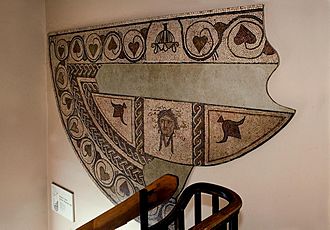Dalton Parlours Roman villa facts for kids
Quick facts for kids Dalton Parlours Roman villa |
|
|---|---|

The Dalton Parlours mosaic on display in the Yorkshire Museum
|
|
| General information | |
| Architectural style | Romano-British Villa |
| Location | Collingham, West Yorkshire, England |
| Country | United Kingdom |
| Construction started | c.4th century |
The Dalton Parlours Roman villa was a large, fancy Roman house located near Collingham, West Yorkshire, in England. It's now a special protected site called a scheduled monument because it's so important for history. This villa gives us a peek into what life was like in Roman Britain.
Contents
Discovering the Roman Villa
The Dalton Parlours site was first found in 1854. A person named F. Carroll started digging there in 1855. During these first digs, they found two buildings. These buildings had special heating systems called hypocausts. They also found a beautiful mosaic showing the Medusa.
Later Excavations and Ancient History
More digging happened in 1977 to save parts of the site before new building work. This big dig explored about 3.5 acres of land. It showed that people lived here even before the Romans. An Iron Age settlement was found right under the Roman villa!
The Roman villa itself was built around the 3rd century AD. Some clues suggest there might have been activity here even earlier, in the 2nd century. Old Roman coins found at the site date from AD 270 to 355.
Life After the Romans
After the Romans left Britain, new people came. These were the Anglo-Saxons. They built their own homes on the site. They even used some of the old Roman building materials. A grave from the 7th century AD was also found here. This shows that the site was important for a very long time.
Exploring the Roman Villa Buildings
The Dalton Parlours site had several villa buildings. They were built one after another over time. The main building was quite large, about 30 meters long and 16 meters wide. It was built facing east to west.
Inside the Main Villa
The main villa building had three rooms connected by a long hallway. The rooms on the eastern side had a hypocaust. This was an ancient Roman heating system. Hot air would flow under the floors and through the walls to keep the rooms warm. The room on the western side held the famous Medusa mosaic.
The Roman Bath-House
Romans loved to bathe! A separate bath-house was found south of the main villa building. This would have been a place for people to clean themselves and relax. Other smaller buildings were also part of the villa complex.
The Famous Medusa Mosaic
One of the most exciting finds at Dalton Parlours was a large mosaic. It shows the face of Medusa, a creature from ancient Greek myths. This amazing artwork was carefully moved to the Yorkshire Museum.
It was put on display there by 1881. Today, you can still see the Medusa mosaic at the museum. It's attached to a wall next to a staircase, so many visitors can admire it.

